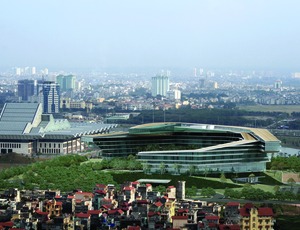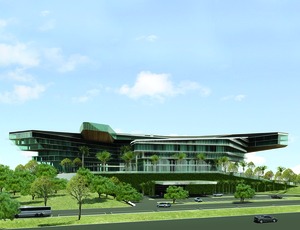NEW YORK DESIGNERS are as familiar with high-rise work as any designers in the world. So when a New York-based team was assembled to deliver a new 450-room hotel and convention facility in the heart of Hanois new central business district, a skyscraper seemed the obvious choice to reflect the rise of Vietnams bustling economy. But rather than go vertical, city officials asked developers of the new JW Marriott Hanoi to create a dramatic profile closer to grade.


The resulting design for an 800,000-sq-ft structure by Carlos Zapata Studio, New York, is eight stories at its highest. But it makes its mark, both visually and structurally, with an aggressive use of cantilevering to evoke characteristics of a dragona nod to traditional imagery that reflects the contour of Vietnams coast.
Its a modern interpretation of a symbol from its past, says Anthony Montalto, principal at Zapata. We tried to extract the idea of a dragon, not so much literally in its form, but in some of the characteristics.
Expressing a dragons tail and head in the horseshoe-shaped building turned out to be a monster of a structural engineering task for New York-based Leslie E. Robertson Associates (LERA), which developed four separate truss systems to support deep cantilever frames, in addition to an outward-and-upward sloping theme for the whole structure. And the cantilever frames are no small feat to execute for the project team led by Turner International, the construction manager arm of the New York-based contractor, which broke ground last summer and plans to hand off the completed building to the local owner, Bitexco, in June 2012.
Large and Luxurious
The hotel is aiming for five-star status and a central role in Hanois new master plan with its location on a 19-acre site next to a man-made lake and the National Convention Center. Local media reports cited the projects cost at $130 million when it was unveiled in 2009. In addition to two ballrooms, three restaurants, a parking garage and a full complement of standard hotel amenities, the new venue will have a glass-enclosed rooftop swimming pool supported on a cantilever frame. The building spreads out at various elevations, with some reaching four stories and others up to the seventh and eighth floors. The pool sits at the highest level.
Foundation work finished in December 2010 and crews are currently building out the reinforced concrete superstructure, with topping out slated for July, says Michael Doring, project director for Turner International. Other current tasks include MEP coordination, structural steel fabrication for the cantilever truss systems and completion of a guest-room mock-up. The building will be enclosed by October and the facade erected by December, he adds. Doring says the building will employ nearly 70,000 cu yd of concrete, 9,500 tons of rebar and 2,300 tons of structural steel.
Turners New York office played a big role in developing the guest-room mock-up, a task aimed at establishing quality standards for the interior finishes and an installation model for MEP services, Doring says. Our N.Y.C. office did a 3D model of the mock-up room for clash detection and general coordination, he adds. The model is also being used to show proposed MEP revisions of the mock-up based on Marriott and Bitexco review comments.
In addition, teams led by Zapatas Montalto and LERAs Seokkwon Jang, a senior associate on the structural design, are also based in New York and handled many key tasks from the Big Apple. A big part of their focus was the cantilever frame design. Its complexity prompted Zapata to bring on LERA to work on the plan to merge the steel trusses of the main cantilevers into the reinforced concrete frame, he adds.
This is a very unique and rare use of cantilevers, LERAs Jang says.
Varied Truss Structures
Each truss structure is unique, jutting certain floors out over the building edge at varying lengths and in distinct shapes and sizes. For instance, the 180-ft-long northern truss will hold guest rooms, with about 90 ft cantilevered and 90 ft of a back span that connects to the concrete superstructure. The truss will be more than 10 ft at its deepest point.
Dimensions for the swimming pool cantilever frame differ, in part, because it uses parallel twin trusses roughly 5 ft apart. One cantilevered portion of this section extends nearly 70 ft while the other stretches about 26 ft, though they have identical back spans of about 78 ft.
The southern truss is a two-level system, with one branch above the seventh floor and the other below the fifth floor to support a cantilever frame that holds about 14 guest rooms on the fifth and sixth floors, Jang says. That southern cantilevered portion reaches as far as 131 ft. The western cantilever frame is made of reinforced concrete, extending about 50 ft, with another 60 ft of back span.
Jang says one common element is that the main truss chords use very heavy steel wide flanges or reinforced plates.
Another unifying structural theme is the buildings outward slope, with cantilever frames stretching each floor out about 4 ft from the one below it. At the top, the eighth floor is about 26 ft off of the building base.
Doring expects the projects truss work, which begins in May, to be very challenging as detailed construction sequences and stringent quality control are required to control deflections and distribute loads properly.




Post a comment to this article
Report Abusive Comment